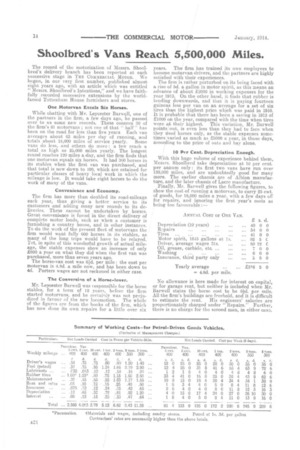Shoolbred's Vans Reach 5,500,000 Miles.
Page 14

If you've noticed an error in this article please click here to report it so we can fix it.
The record of the motorization of Messrs. Shoolbred's delivery branch has been reported at each successive stage in THE COMMERCIAL MoToR. We began, in our very first number, published almost eL,eht years ago, with an article which was entitled " Messrs. Shoolbred's Intentions," and we have faithfully recorded successive extensions by the worldfamed Tottenham House furnishers and stores.
One Nlotorvan Excels Six Horses.
While chatting with Mr. Leycester Barwell, one of the partners in the firm, a few days ago, he passed. over to us some new records. These concern 30 of the firm's 61 motorvans ; not one of that " half" has been on the road for less than five years Each van averages about 63 miles per day of running, and totals about 18,000 miles of service yearly. Some vans do less, and others do more : a few reach a total as high as 25,000 miles yearly. The longest round reaches 120 miles a day, and the firm finds that one motorvan equals six horses. It had 300 horses in its stables when the first van was purchased, and that total is now down to 100, which are retained for particular classes of heavy local work in which the mileage is low. It would take eight horses to do the work of many of the vans.
Convenience and Economy.
The firm has more than doubled its road-mileage each year, thus giving a better service to its customers and adding many new rounds to its deliveries. These cannot be undertaken by horses. Great convenience is found in the direct delivery of complete motor loads, such as when a customer is furnishing a country house, and in other instances. To do the work of the present fleet of motorvans the firm would want fully 600 horses in its stables, as many of the long trips would have to be relayed. Yet, in spite of this wonderful growth of actual mileage, the stable expenses show an increase of only 2600 a year on what they did when the first van was purchased, more than seven years ago. The horse-van cost was 6l2d. per mile : the cost per motorvan is 4.8d. a mile now, and has been down to 4d. Porters wages are not reckoned in either case.
The Conversion of a Horse-lover.
Mr. Leycester Barwell was responsible for the horse stables, for a term of 12 years, before the firm started motorvans, and he certainly was not prejudiced in favour of the new locomotion. The whole of the figures are from the books of the firm, which has now done its own repairs for a little over six
years. The firm has trained its own employees to become motorvan drivers, and the partners are highly satisfied with their experiences. The firm is rather perturbed on its being faced with a rise of 5d. a gallon in motor spirit, as this means an advance of about £2000 in working expenses for the year 1913. On the other hand, it finds that rubber is tending downwards, and that it is paying fourteen guineas less per van on an average for a set of six tires than the highest price which was paid in 1910. It is probable that there has been a saving in 1913 of £1000 on the year, compared with the time when tires were at their highest. This variation, Mr. Barwell points out, is even less than they had to face when they used horses only, as the stable expenses sometimes varied as much as 23000 a year, in those days, according to the price of oats and hay alone.
10 Per Cent. Depreciation Enough.
With this huge volume of experience behind them, Messrs. Shoolbred take depreciation at 10 per cent. per annum only : its first two vans have run over 130,000 miles, and are undoubtedly good for many more. The earlier chassis are of Albion ma,nufacture, and the later chassis of Lacre manufacture.
.Finally, Mr. Barwell gives the following figures, to show the cost of running a motorvan, to carry 25 cwt. of goods,. for 18,000 miles a year, with a few days off for repairs, and ignoring the first year's costs as being too favourable : No allowance is here made for interest on capital, or for garage rent, but neither is included when Mr. Barwell states the horse cost to be 6id. per mile. All the firm's buildings are freehold, and it is difficult to estimate the rent. His engineers' salaries are proportionately charged under "Repairs." Further, there is no charge for the second man, in either case.






















































































